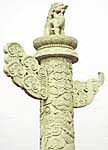|
During the National Day Big parade this year, one of the roiling floats
- whose Disney - like rolling stock of reform - featured a massive Hua Biao, or Decorated Pillar of the kind that are situated both in and outside the Gate of Heavenly Peace on Tiananmen Square. In recent years Hua Biao have become a symbol of all that is Chinese, but their story, like that of all icons, contains mixed
messages.
Over the 1998 Spring Festival, the commercial-minded overseers of old Wangfujing (the avenue once know as Morrison Street in honor of the Australian journalist George Morrison who lived there at the turn of the century) set up pairs of inflatable red Hua Biao at either end of Beijing's
paramount shopping street. The oral historian Sang Ye and I, having been invited to contribute an installation to the Third Asia-Pacific Triennial of Contemporary Art in Brisbane Australia which opened on September 9, 1999, decided to nab a pair of the pillars and set them up in the Antipodes as our homage to high art.
The third APT features artists from throughout the region. The Chinese participants include Cai Guoqiang (Quanzhou-Tokyo-New York), Xu Bing (Beijing-NY, and recent winner of a US$350,000 Macarthur "Genius" Award), Feng Mengbo (Beijing), Zhang Peili (Hangzhou), as well as others from various locales. The tumescent Hua Biao are situated at the entrance to the gallery that lies along the scenic Brisbane river. No one could miss our meaning. Inside the artistic keep itself we set up a video player that shows a short film edited by Sang Ye that reflects the political vicissitudes that the Hua Biao have stood witness to this century. The 10-minute show also features a series of mini-interviews conducted by Sang Ye with people in Tiananmen who were asked what the Hua Biao are: no one had a clue.
'Hua Biao, a Chinese Totem' is not so much an installation as an inflation, a pumped-up sign buoyed by cultural afflatus, a commercial chimera.
Temporarily erected at the intersection of the Avenue of Eternal Peace and Wangfujing, the mercantile center of Beijing, these two inflatable, festive red Hua Biao were made to be puncture-proof and cigarette-safe. They are a concrete but collapsible expression of cultural appropriation.
During the 1998 Spring Festival they were placed at the crossroads of the city, at the fulcrum of commerce and politics. The red totem poles celebrated the wealth generated by China's reforms, but in their form there is a more coded message about the insubstantiality of prosperity. They are decked in the symbolism of the Spring Festival, a cheerful message of good fortune on a cartoon tower of classic Chinoiserie. Spring Festival is a time of renewal and rejoicing, when debts are retired and harmony celebrated. But for me and Sang Ye the twin Hua Biao were also an exclamation mark emphasizing the unsettling evanescence of inflated, or bubble, economies. The garish kitsch of the columns entwined with the dragon totem of the past is a pronouncement on the fetishes of today, the commerce of signs and the triumphalism of capital.
The original, 500 year-old marble Hua Biao pillars that are carved with a coiling imperial dragon are positioned at the entrance of the Forbidden City facing Tiananmen Square. Once emblematic of dynastic fiat, after 1949 the Hua Biao were claimed by the leaders of the People's
Republic of China as symbols of the New China. After adorning socialist art works (and state-produced cigarette packets) for decades, in 1998 they were engorged by the forces of commerce. Produced in all-weather synthetic, the blow-up red pillars were thrown up at the entrance to Wangfujing, the people's
palisade of consumption.
The Hua Biao pillar is itself a stylized icon that evolved from an ancient dagger-axe or halberd (ge in Chinese). Originally, it was stuck in the ground as a simple road marker or sign, placed in such a way as to indicate to an army on the march the direction of their advance.Later the Hua Biao did more than just give directions. Rulers allowed people to attach petitions or inscribe comments on the body of the pillars so they could gauge popular sentiment.
These poles could no longer be moved, or used as weapons. Stasis made them symbolic. They were an ancient, encapsulated 'Hyde Park,' a place for the expression of public opinion. No petitioner was to be persecuted for what they wrote on the columns. From approximately 300BC, the pillars were placed at the entrance to the royal keep. As the kings became emperors it came to be accepted that the ruler, the True Dragon and Son of Heaven, could do no wrong. For common people or even officials to contradict or criticize the Dragon Throne was an act of rebellion.
Accordingly, the Boards of Criticism (fei bang zhi mu) were transmuted from being a benign reminder to the rulers into a threatening accusation.
No longer were the columns used to alert power holders of popular opinion; they were covered with elaborate carvings of the imperial dragon. No one would dare deface these sacred creatures with writing. Thus, for some 1,800 years, the columns have been decorative pillars, a royal totem.
This is how they came to be called Hua (decorated) Biao (columns).
Hua Biao pillars were once set up outside the palace as a recognition of the need for accountability in government. But they are a debased symbol, tools of expression that lost one function only to have it replaced by another. Whereas they once admonished rulers, now they are a warning to the ruled. As the Taiwan writer and historian Li Ao has said of the pillars: 'They are the tears of China; the Hua Biao is China's
cross.'
The inflatable Hua Biao are a commercial riff on a statist symbol. Internal appropriation by the powers that be is one thing, cross-border plunder another.
The export of artifacts from China has a long history. The most famous act of cultural pillage was perhaps the stripping of the garden-palaces of the Yuan Ming Yuan, the 'Manchu Versailles,' by Anglo-French troops in 1860. Among the priceless objets d'art captured for sale and exhibition was an ephemeral creature. Captain Hart Dunne of the Wiltshire Regiment nabbed a Pekingese lion-dog that he presented to Queen Victoria. In light of its provenance the canine was dubbed
'Lootie,' and a portrait was commissioned from Her Britannic Majesty's favorite dog artist, Friedrich Wilhelm
Keyl.
Our loot is of a different order. The Hua Biao inflation is a limited-edition object, a one-off copy of an imperial artifact with socialist associations. We have plundered through purchase, and positioned this plinth with purpose at the entrance of the Queensland Art Gallery as a playful observation and observer of the commerce in art and culture with which the Asia-Pacific Triennial engages.
For Australian viewers the associations elicited by these red shafts may be complex and layered. Our native wit will suggest gustatory and lewd associations. A cherry-ripe colored spring roll up-ended for a festive gallery opening; a garish cocktail sausage skewered by a whimsical cloud; a Dr. Seuss dildo perversely pierced; or some intercontinental projectile crash-landed, or ready on its launch-pad at this northern artistic Woomera [a rocket launch site in South
Australia].
The erectile Hua Biao recalls the 'Sea Plug' of the phantasmagorical Chinese tale of Monkey (Sun
Wukong) from the classic Chinese novel Journey to the West. In the Buddhist adventure story a canny Monkey pulls the plug on the Sea Dragon's empire, but our Hua Biao stopper does not drain the waters; it is a projecting manhole cover advertising a sea of commerce. Does the hole it
plugs come out in China? This inflation is not a painted word (pace Tom Wolfe) that dare not speak its name. It is a reconstructed totemic advertisement that airily announces its presence.
Geremie Barme is a writer, academic, and filmmaker based in Australia. |



